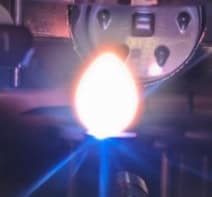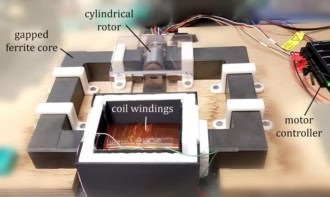
Researchers in China report that they have observed both superconductivity and an insulator-to-metal transition in sodium ytterbium (III) selenide (NaYbSe2) simply by applying pressure to it. This inorganic substance, which is also a quantum spin liquid (QSL) candidate, could therefore become a new platform for investigating superconductivity in compounds that have electrons in their f orbitals, and for exploring the mechanisms of unconventional superconductivity in these materials.
Quantum spin liquids (QSLs) are solid magnetic materials that cannot arrange their magnetic moments (or spins) into a regular and stable pattern. This behaviour contrasts with that of ordinary ferromagnets, in which all the spins point in the same direction, or antiferromagnets, in which the spins point in alternating directions. Instead, the spins in a QSL constantly change direction in a fluid-like way – even at ultracold temperatures near absolute zero – and are thus said to be “frustrated”.
The late physicist and Nobel laureate Philip W Anderson proposed the existence of QSLs in the early 1970s, when he was studying the ground state of antiferromagnetically interacting spins on a triangular crystal lattice. Although Anderson did not follow up the idea at the time, he returned to it in 1986 after the discovery of high-temperature superconductivity in copper oxides (cuprates). A year later, his work bore fruit when he uncovered a potentially crucial link between QSL theory and “unconventional” high-temperature superconductivity. He described this link in the so-called resonant valence bond theory.
“Parent states”
Today, QSLs are thought to be the “parent state” for high-temperature unconventional superconductivity in cuprates. This class of superconductors could have applications in many areas, including energy grids, levitating transport and even quantum computing, but the physics underlying them is still not very well understood. Studying QSLs is thus important for condensed-matter physicists if these applications are to see the light of day.
A team of researchers jointly led by Run-Ze Yu and Chang-Qing Jin of the Institute of Physics at the Chinese Academy of Sciences, and He-chang Lei of Renmin University of China in Beijing, used a diamond anvil cell to measure the electronic conductivity of NaYbSe2 under varying high pressures (up to 126 GPa) and a high magnetic field. This crystalline material features a triangular lattice of 4f-orbital Yb3+ions bonded to six equivalent Se2- atoms to form YbSe6 octahedra. These YbSe6 octrahedra share corners with six equivalent NaSe6 octahedra, while sharing edges with six equivalent YbSe6 octahedra.
The researchers found that their sample acts as a paramagnetic insulator (a material with a permanent magnetic dipole moment) at applied pressures below 8 GPa. As the pressure increases from 8 GPa to 50 GPa, the material remains an insulator, but its resistance decreases by nearly eight orders of magnitude. A metallic phase is eventually observed at about 60 GPa and further increases in pressure lead to the emergence of a superconducting state at 103 GPa, with a superconducting transition temperature of 8 K.
Mott transition
This transition from insulator to conductor is known as a Mott transition. Because the material contains exotic spin excitations carrying fractional quantum numbers at low energies, its metallic state behaves like a non-Fermi liquid – meaning that its electrical conductivity depends linearly on temperature. “The origin of the superconductivity should therefore be exotic,” Yu explains. “This implies that the relationship to the resonant valence bond theory proposed by Anderson for copper oxide superconductors needs to further investigated in experiments.”
The fact that the researchers observed such a transition by simply applying pressure means that it is an intrinsic, physical property of the material, free from chemical transformations that are usually introduced by doping. And since Yb3+ ions contain f-electrons, Yu adds that the NaYbSe2 system provides a new platform to investigate unconventional superconductivity mechanisms in such compounds. “The work will certainly help researchers gain a deeper understanding of the interplay between the QSL and unconventional superconductivity,” he tells Physics World.

Superconductivity endures to 15 °C in high-pressure material
Members of the team, who report their work in Chinese Physics Letters, say they will now study the nature of the insulator-to-metal transition in NaYbSe2 in-depth, as well as the intrinsic physical properties of superconductivity in this QSL. “We will also be focusing on the possibility of ‘heavy fermion’ phenomena in this compound,” Yu adds. Such phenomena, he explains, arise when the conduction electrons, which are fermions, move as if they were hundreds of times more massive than electrons in conventional metals, like copper. This large “effective mass” comes about thanks to strong electron-electron interactions, which are also thought to play an important role in high-temperature superconductors.



